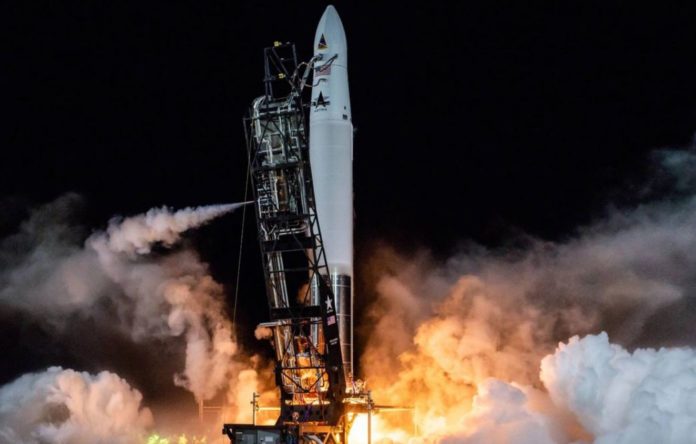Astra and Rocket Lab have both conducted successful orbital flights. A goal that Bezos, despite his billions, has yet to achieve
The rocket LV0007 of the aerospace company Astra has managed to reach the orbit of the Earth only 5 years after its foundation. It took Musk more than six years to get it, and billionaire Bezos is still trying. But they are not the only ones, a rocket from Rocket Labs, a Californian startup, also did it last week.
Musk and his SpaceX are no longer alone as the only ones capable of flying above the Karman line – what the International Aeronautical Federation considers the border between atmosphere and space and which is located 100 km away from the Earth’s surface.
Astra, a Californian company that since 2016 has launched several rockets and has successfully reached space, has managed to overcome it as well. This Saturday, November 20, its LV0007 model took off from the company’s spaceport on Kodiak Island, Alaska, and reached an altitude of 500 km carrying a test payload for the US Space Force.
Astra just reached orbit! 7.61km/sec at our targeted 86.0 degree inclination at an altitude of 500km. The team worked hard for this. We’re just getting started, folks. #AdAstra pic.twitter.com/NiMhCEsuCI
— Chris Kemp (@Kemp) November 20, 2021
The LV0007 is a small disposable two-stage rocket designed to transport satellites into space and can carry a weight of up to half a ton in its fairing. Astra already tried a similar launch in August this year, without much success. One of its five engines shut down within a second of takeoff and the company aborted the mission after two and a half minutes.
“The team has been working very hard on this for many years,” commented Astra CEO Chris Kemp during a post-launch live broadcast. “We have rockets number eight, nine and ten in production, so we are just getting started.”
Mission success for our 22nd launch, Love At First Insight. That's 107 satellites deployed to orbit by Electron now. Welcome to space, @BlackSky_Inc pic.twitter.com/7SGG7Sypa3
— Rocket Lab (@RocketLab) November 18, 2021
In addition to Astra, the ‘startup’ Rocket Lab put two satellites in orbit last week achieving a height of 430 kilometers. It did so with its Electron rocket, which is 15 meters high and can carry payloads of up to 227 kg, less than half that of the LV0007.
Like the Astra rocket, it also has two stages, although the first one can be recovered. Electron ‘boosters’ that fall to Earth are picked up with a helicopter, inspected, their thrusters reconditioned, and brought to the shuttle ready to take off again. This reuse, as with SpaceX rockets, would reduce costs for Rocket Lab and its customers and allow the company to significantly increase its launch rate.
No one overshadows Elon Musk
These successes of Astra and Rocket Lab contrast with the recent failures of the aerospace aviation giants. NASA had to hire SpaceX to transport people to the International Space Station after Boeing delayed its Starliner for the umpteenth time owing to security issues.
Another giant, Lockheed Martin, also has security problems with its Orion spacecraft, the spacecraft that within NASA’s Artemis program will take us to orbit the Moon.
As for the rest of the private companies that have their own rockets, Blue Origin has not yet overcome the tantrum of the sentence that left them out of the contest for building the NASA ‘lander’ that will take humans to the Moon again. Although his latest releases have been making headlines, Jeff Bezos’s company efforts are still an expensive public relations campaign paid for by all Amazon employees.
Not only are they unable to get their spacecraft into orbit, but their own employees have criticized the company’s toxic environment and the lack of security of its technology. Also, its brightest engineers are starting to jump ship. Bad signal.
Virgin Orbit, the company of billionaire Richard Branson, after two failed attempts recently succeeded with its mission ‘Tubular Bells: Part 1’ to bring two small satellites to 500 kilometers from the surface of the Earth. The method they use is not the usual one. A Boeing 747 loads the LauncherOne orbital plane under its wing and releases it when it has reached a sufficient height. Then the LauncherOne’s engines turn on and the ship climbs to the height where it has to drop the satellites.
Virgin Orbit has an ambitious launch schedule planned for next year. “As we move into the next year we will press the accelerator on our production team primarily to get a higher pace and increase at least double that [launch pace] at 23,” the CEO of the company told Space.com.
Both Virgin Orbit and Astra or Rocket Lab are far from the power that SpaceX shows and the trust that its customers put in their space travel. Even so, not everything has been decided, there is more and more competition and we will be attentive to see how this competition between private companies evolves to gain control of commercial space traffic.
You were reading: Elon Musk’s new enemies reach Earth orbit
